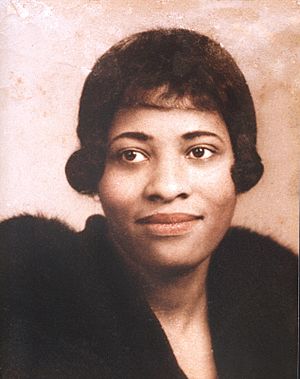Rosie Lee Tompkins facts for kids
Rosie Lee Tompkins (born Effie Mae Martin Howard, 1936–2006) was a famous African-American artist. She was known for making beautiful quilts and fiber art in Richmond, California. Many people, including The New York Times, called her "one of the great American artists." They said her work was a huge artistic achievement of her time. More than 500 of her amazing artworks are kept at the Berkeley Art Museum and Pacific Film Archive.
Contents
Early Life and Quilting
Effie Mae Martin was born on September 6, 1936, in southeastern Arkansas. Her family were sharecroppers, meaning they farmed land owned by someone else and shared the crops. She was the oldest of 15 children. Growing up, she worked hard picking cotton. She also learned to make quilts with her mother.
Rosie Lee Tompkins started making quilts seriously around 1980. At that time, she was working as a nurse in the Bay Area. She believed that God guided her hands when she created her art. Her quilts were often abstract and made up as she went along. They often had a special meaning to her. For example, one quilt called "Three Sixes" was about three family members whose birthdays included the number 6.
Discovering Her Art
Rosie Lee Tompkins was a very private person. She rarely sold her quilts. However, her work was discovered in 1985 by Eli Leon. He was a collector from Oakland who focused on African-American quilts. Leon showed her work on the cover of a catalog for an exhibition. This show was called Who'd A Thought It: Improvisation in African-American Quiltmaking. It first opened in San Francisco in 1987 and then traveled for several years.
Tompkins' quilts were featured in a special show just for her at the Berkeley Art Museum and Pacific Film Archive (BAMPFA) in 1997. Her art was also shown at the Whitney Museum of American Art in 2002. One of her images can be seen on the website of the National Museum of Women in the Arts in Washington, DC. In 2016, her quilts were part of a show with five quilt artists at the Oakland Museum of California.
Lawrence Rinder, who was the curator for the Berkeley show, greatly admired her work. He said her quilts showed amazing skill with color, texture, and design. He felt her art was incredibly inventive and original.
Artistic Style and Materials
Tompkins' quilts were unique. She did not use old clothes or fabric scraps. Instead, she bought new fabrics especially for their textures and how they reflected light. She used materials like velvet, fake fur, wool, silk, and Lurex.
She worked with the traditional idea of a quilt block. However, she made them in many different sizes. She also freely changed their shapes and used bright, strong color contrasts. People have described her style as "geometric anarchy" and "riotous mosaics."
Some of her well-known quilts include Tents of Armageddon Four Patch (1986) and Three Sixes (1987). She also made Half-Squares Put-Together (1988) and Put Together with Letter "F" (1985).
A Major Art Collection
In 2019, the Berkeley Art Museum and Pacific Film Archive (BAMPFA) received a huge gift. They got almost 3,000 artworks from the Eli Leon Collection. This included over 500 quilts by Rosie Lee Tompkins. These artworks will now have a permanent home at the museum.
BAMPFA then created a special exhibition called Rosie Lee Tompkins: A Retrospective. This show opened on February 19, 2020. It had to close early because of the COVID-19 shutdown. Even so, The New York Times called it a "triumphal retrospective." They said it proved her place as one of America's greatest artists.
Personal Life
Rosie Lee Tompkins was married and divorced twice. "Howard" was one of her married names. She was a very private person. She wanted to protect her own privacy and that of her family. Her family included her mother, several children and stepchildren, and many siblings, grandchildren, and great-grandchildren.
Death
Rosie Lee Tompkins passed away at her home in Richmond, California, on December 1, 2006. She was 70 years old.
Images for kids



